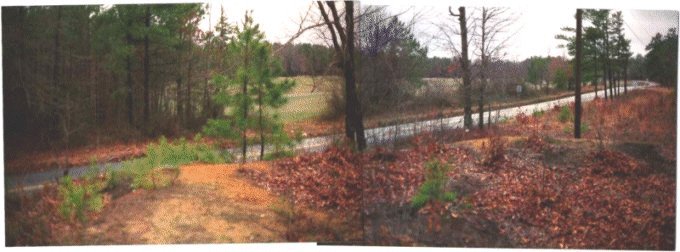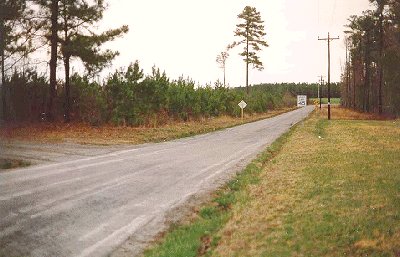
Five Forks
April 1, 1865
By the spring of 1865, the Confederacy was on the verge of collapse. In the Carolinas, Joe Johnston could do nothing to stop Sherman. The Shenandoah Valley was no longer the breadbasket of the Confederacy, and at Petersburg, Grant was planning to shift troops west to cut off Lee's supply and escape route along the Southside Railroad. Grant's 125,000 men faced only 57,000 Confederates, and Sheridan then arrived from the Valley with 5,700 cavalry. Lee was already planning to evacuate Petersburg to join Johnston in North Carolina and destroy Sherman. To keep Grant from shifting troops west and to destroy his supplies, Lee ordered an attack on Fort Stedman east of Petersburg. This attack was only a temporary success, and Grant began to implement his plan.
South of the Appomattox River, the IX Corps held the trenches. Further to the left, the II, V, and VI Corps were positioned on the flank. Grant shifted 15,000 men of the XXIV Corps and Mackenzie's cavalry from north of the Appomattox, leaving the XXV Corps to defend the area near Richmond. The XXIV Corps took over the positions of the 35,000 men of the II and V Corps, who joined Mackenzie and Sheridan in the flanking operation.
The cavalry under Sheridan and V Corps under Warren were ordered to sever the Southside Railroad. Lee assigned Pickett to stop them with his own division and the cavalry of Fitzhugh Lee.

Lewis Farm or Quaker Road
On March 29th, Warren's V Corps advanced on the Quaker Road north toward the Confederate position on the White Oak Road. Chamberlain's brigade of Griffin's division was in the vanguard. After an opposed crossing of Gravelly Run, Chamberlain's brigade was stopped by the Confederate brigades of Wise and Wallace under Bushrod Johnson at the Lewis Farm. Chamberlain was hit, but he was saved by items in his pocket that deflected the bullet. The ruins of the Lewis house are on the right of the picture, and Arnold's sawmill is near the road on the left of the picture near the other buildings. After the initial Federal attack, the troops fell back to this house and fought off the Confederates attacking from the woods in the distance. The fighting was desperate, and the Rebel attackers were thrown back by canister shot from a battery that was brought up to the Lewis house. This, and reinforcements from Gregory's and Bartlett's brigades won the field for the Yankees. The Confederates withdrew to their earthworks on the White Oak Road. Warren suffered 370 killed and wounded versus at least 330 Rebel casualties.
Sheridan advanced on Dinwiddie Courthouse farther west and met Pickett's force there on March 31, 1865. Pickett's men flanked Sheridan, and may have been able to push him back if the day had been long enough. The V Corps, which connected Sheridan to the main army, also had fought that day at the White Oak Road.

Battle of White Oak Road
This is photograph from the location of a Confederate gun battery along the line of the White Oak Road near the intersection with the Claiborne Road. The Confederates of Bushrod Johnson's division, which had been pushed back at the Lewis Farm, retired to these fortifications along the White Oak Road. On March 31st, General Lee rode to this location to investigate the activities of the Union V Corps. If the Federals took the White Oak Road, Pickett would be cut off from the main army. When Ayres division of the V Corps appeared in front of these earthworks, Lee ordered an attack. Johnson's four brigades pushed back Ayres' division, then Crawford's division. Griffin's division, however, held, and the Confederates were pushed back to their earthworks with the help of the II Corps. Had the Confederate counterattack been successful, Sheridan would have been isolated.
That evening, Warren moved west to cut off Pickett from the main army. Recent rains had washed out bridges and had made the roads muddy, so Warren was unable to cut Pickett off. Pickett saw the danger and withdrew to Five Forks where his troops dug in. On the morning of April 1, 1865, Sheridan's men awoke to find the Confederates were gone. Warren's V Corps was now placed under Sheridan's command. The cavalry determined that the new Confederate position was at Five Forks, so Sheridan ordered Warren to move north to the White Oak Road between Pickett and the main army. Then, he would move west and attack Pickett's left flank while Sheridan's cavalry attacked his front and right flank. Sheridan's men waited in front of Five Forks for hours, and at 4:00, Warren's V Corps was finally ready for battle. By this time, Pickett had assumed that there would be no battle that day and was two miles to the rear along with Fitzhugh Lee at Gen. Rosser's reserve position dining on baked shad.

The Angle
This is a picture of the Confederate left on the White Oak Road. The Confederates were entrenched on the left side of the road facing toward the right of the picture. An angle was formed because the Confederate flank was refused, meaning that their line extended left at a 90 degree angle to protect from a flank attack. Near the dirt road on the far left of the picture, the Confederate line angled to the left for 150 yards. The Ayres division of V Corps attacked directly down this road, and were not visible until they rounded the bend in the road visible in the distance. They stormed the Confederate position and continued to advance down the Confederate line. Sheridan himself followed his troops into the angle. Griffin's and Crawford's divisions and Mackenzie's cavalry were off to the left off the picture advancing deep into the Confederate rear.
Back to Civil War Virtual Battlefield Tours